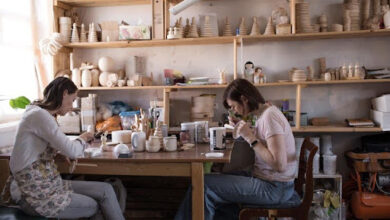https://multigrafico.com/edificio-clock-shadow-ecologia-y-estilo/

Welcome to the world of sustainable architecture, where style meets eco-consciousness! Today, we bring you a fascinating building that seamlessly blends cutting-edge design with environmentally-friendly features. Prepare to be amazed by the Clock Shadow Building and its commitment to both aesthetics and sustainability.
Located in [city], this architectural masterpiece stands tall as a shining example of how modern buildings can make a positive impact on our planet. From its inception, the Clock Shadow Building was conceived with one goal in mind: to create an urban oasis that harmonizes with nature and promotes a greener future.
Join us on this virtual tour as we explore the innovative design elements, green technologies, and community benefits behind this remarkable structure. Get ready to witness firsthand how sustainable living can coexist beautifully with contemporary style. So let’s dive right into it and discover what makes the Clock Shadow Building truly special!
The Sustainable Design Features of the Building
The Clock Shadow Building stands out not only for its striking architecture but also for its commitment to sustainability. This eco-friendly structure incorporates a range of design features that make it stand as a shining example of sustainable building practices.
One notable sustainable feature is the use of solar panels on the roof, which harnesses the power of the sun to generate clean energy. These panels help to reduce dependence on fossil fuels and lower greenhouse gas emissions. Additionally, the building utilizes rainwater harvesting systems to collect and reuse water, reducing strain on local water resources.
Another innovative aspect of the Clock Shadow Building’s design is its extensive use of natural lighting. Large windows and skylights allow ample sunlight into the interior spaces, minimizing the need for artificial lighting during daylight hours. Not only does this save energy but it also creates a pleasant environment filled with natural light.
In terms of materials used, sustainability was at the forefront throughout construction. The building incorporates recycled and locally sourced materials whenever possible, reducing environmental impact associated with transportation and production processes.
Furthermore, green roofs are incorporated into multiple levels of the building, providing insulation and absorbing rainwater runoff while adding an aesthetic touch to both exterior and interior spaces.
These sustainable design features demonstrate how thoughtful planning can lead to buildings that are not only visually stunning but also environmentally responsible. By incorporating green technology in their designs, architects have paved a way towards more eco-friendly construction practices that benefit both people and our planet.
How the Building Incorporates Green Technology
The Clock Shadow Building is not just a visually striking structure; it also incorporates innovative green technology to minimize its impact on the environment. From its inception, sustainability was at the forefront of its design.
One of the ways this building embraces green technology is through its energy-efficient systems. The use of solar panels on the rooftop harnesses the power of the sun to generate electricity, reducing reliance on traditional energy sources. Additionally, motion sensors are installed throughout the building to control lighting and temperature, ensuring that resources are not wasted when rooms are unoccupied.
Water conservation is another key feature in this eco-friendly edifice. Rainwater harvesting systems collect and store rainwater for non-potable uses such as irrigation and flushing toilets. Low-flow fixtures further reduce water consumption without compromising comfort or functionality.
In terms of waste management, recycling initiatives have been implemented throughout the building. Separate bins for different types of recyclables encourage tenants to dispose responsibly and minimize landfill contribution.
Furthermore, sustainable materials were carefully selected during construction to enhance both environmental performance and occupant health. Recycled materials like reclaimed wood were utilized whenever possible while low-VOC paints and finishes contribute to better indoor air quality.
By incorporating these innovative green technologies into its design, The Clock Shadow Building sets an example for future developments by showcasing how sustainable practices can be seamlessly integrated into modern architecture without sacrificing style or functionality.
Benefits of Eco-Friendly Buildings
Eco-friendly buildings have become more than just a trend in recent years. They offer numerous benefits that go beyond their stylish design and eye-catching aesthetics. One of the most significant advantages is their positive impact on the environment.
By incorporating sustainable materials and energy-efficient systems, eco-friendly buildings reduce carbon emissions and promote a greener lifestyle. They utilize renewable energy sources such as solar panels, geothermal heating, and rainwater harvesting to minimize reliance on traditional resources.
Additionally, these buildings prioritize efficient waste management strategies by implementing recycling programs and utilizing composting systems. This not only reduces landfill waste but also promotes a circular economy where materials are reused or repurposed instead of being discarded.
Another major benefit of eco-friendly buildings is improved indoor air quality. By using low-toxicity building materials and properly ventilating spaces, these structures create healthier living environments for occupants. This has been shown to enhance productivity, reduce absenteeism, and contribute to overall well-being.
Furthermore, eco-friendly buildings save money in the long run. With features like energy-efficient appliances, insulation systems, and LED lighting fixtures, they significantly lower utility bills over time. The initial investment may be higher than traditional construction methods; however, the cost savings from reduced energy consumption make them financially viable in the long term.
Choosing an eco-friendly building offers multiple benefits for individuals as well as communities at large. Whether it’s reducing environmental impact or improving indoor air quality while saving money on utilities – these sustainable structures play a crucial role in creating a better future for both us and our planet
Comparison to Traditional Buildings
When it comes to sustainable architecture, the Clock Shadow Building stands tall, quite literally! But how does it compare to traditional buildings? Let’s take a closer look.
Traditional buildings often rely heavily on non-renewable resources during construction. Concrete and steel production contribute significantly to carbon emissions. In contrast, the Clock Shadow Building prioritizes eco-friendly materials like recycled steel and locally sourced wood.
Furthermore, energy consumption in traditional buildings is typically high due to inefficient heating and cooling systems. The Clock Shadow Building tackles this issue head-on by incorporating energy-efficient technologies such as solar panels and geothermal heating.
Water usage is another area where the two types of structures differ greatly. Traditional buildings consume excessive amounts of water for various purposes. However, the Clock Shadow Building features water-saving fixtures and a rainwater harvesting system that reduces its overall water footprint.
In terms of indoor air quality, traditional buildings can be notorious for poor ventilation and high levels of pollutants. On the other hand, the Clock Shadow Building boasts an advanced HVAC system with efficient filtration mechanisms that provide clean and fresh air for occupants.
Let’s not forget about aesthetics! While many may argue that traditional buildings have their own charm, there’s no denying that the modern design of the Clock Shadow Building sets it apart from its counterparts in terms of style and innovation.
In conclusion (sorry!), when comparing sustainable architecture to traditional building practices, it becomes evident why structures like the Clock Shadow Building are leading us towards a greener future. By incorporating eco-friendly materials and cutting-edge technologies while maintaining functionality and aesthetics, these innovative constructions prove that sustainability doesn’t have to come at the expense of style or comfort.
Impact on the Community and Environment
The impact of the Clock Shadow Building extends far beyond its eco-friendly design and sustainable features. This innovative structure has become a symbol of hope for the community, showcasing how thoughtful architecture can positively influence both people and the environment.
One significant way in which this building impacts the community is by providing a space for various businesses that share a commitment to sustainability. From organic grocery stores to green energy companies, these tenants not only contribute to the local economy but also inspire others with their environmentally conscious practices.
Moreover, the Clock Shadow Building serves as an educational hub, hosting workshops and events that promote sustainable living. The building’s design itself acts as a teaching tool, demonstrating how it is possible to integrate green technology seamlessly into architectural aesthetics.
On top of that, this remarkable structure encourages social interaction and engagement among residents and visitors alike. Its vibrant rooftop garden offers a peaceful oasis where people can connect with nature while enjoying breathtaking views of Milwaukee’s skyline. This communal space fosters a sense of belonging and unity within the community.
Furthermore, by incorporating renewable energy sources such as solar panels and geothermal heating systems, the Clock Shadow Building significantly reduces its carbon footprint. It sets an example for other buildings in the area to adopt similar eco-friendly practices.
Let’s not forget about the positive impact on air quality! With features like green roofs and natural ventilation systems, this building helps improve overall air quality in its vicinity—a breath of fresh air amidst urban development!
It is clear that the Clock Shadow Building goes beyond just being an architecturally stunning structure—it plays an essential role in promoting sustainability within both its immediate community and beyond. By setting new standards for what constitutes environmentally friendly design and construction practices, it paves the way for future generations to embrace greener alternatives in their own projects—ushering us into a brighter future where style meets ecological consciousness!
Conclusion: The Future of Sustainable Architecture
The Clock Shadow Building stands as a shining example of what the future holds for sustainable architecture. With its innovative design and incorporation of green technology, it serves as an inspiration for architects, developers, and communities around the world.
As we continue to face pressing environmental challenges, it is crucial that we prioritize sustainability in our built environment. Eco-friendly buildings like the Clock Shadow Building not only reduce our carbon footprint but also provide numerous benefits to both individuals and society as a whole.
By embracing sustainable practices and adopting green technologies, we can create buildings that are not only aesthetically pleasing but also energy-efficient and environmentally responsible. This approach will undoubtedly lead us towards a more sustainable future.
As architects and designers push boundaries in search of new ways to minimize environmental impact while maximizing functionality and beauty, we can expect even more groundbreaking structures like the Clock Shadow Building to emerge. These structures will redefine what is possible in terms of sustainable construction methods, materials usage, energy efficiency, and waste reduction.
Furthermore, with increasing awareness about climate change and growing demands for eco-conscious practices from consumers and governments alike, there is no doubt that sustainable architecture will play an increasingly vital role in shaping our cities’ landscapes.
In conclusion (without using those exact words), the Clock Shadow Building showcases how ecologically conscious design can seamlessly blend style with sustainability. It serves as a beacon of hope for a greener future where every building embraces green technology. As we move forward into this new era of architecture, let us remember that each structure has the power to make a significant difference in mitigating climate change while creating beautiful spaces for people to live and thrive within their communities.




